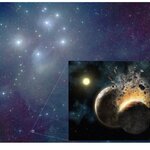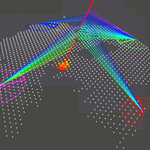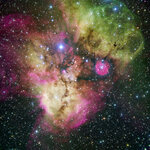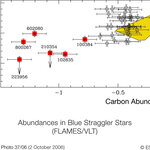Space

NASA's Hubble Space Telescope has probed the bright core of Comet 17P/Holmes, which, to the delight of sky watchers, mysteriously brightened by nearly a millionfold in a 24-hour period beginning Oct. 23, 2007.
Comet 17P/Holmes is a periodic comet in our solar system.
On November 4, 2007, Comet 17P/Holmes was 1.62 Astronomical Units from the Earth, and 2.48 Astronomical Units from the Sun. Constellation: Perseus
Astronomers used Hubble's powerful resolution to study Comet Holmes' core for clues about how the comet brightened. The orbiting observatory's Wide Field Planetary Camera 2 (WFPC2)…

Rocky terrestrial planets, perhaps like Earth, Mars or Venus, appear to be forming or to have recently formed around a star in the Pleiades ("seven sisters") star cluster, the result of "monster collisions" of planets or planetary embryos.
Astronomers using the Gemini Observatory in Hawaii and the Spitzer Space Telescope report their findings in an upcoming issue of the Astrophysical Journal, the premier journal in astronomy.
"This is the first clear evidence for planet formation in the Pleiades, and the results we are presenting may well be the first observational evidence that terrestrial…

Known until now as a simple number in a catalogue, NGC 134, the 'Island in the Universe' that was observed by the European Commissioner for Science and Research Janez Potočnik on a visit to ESO's Very Large Telescope at Paranal is replete with remarkable attributes, and the VLT has clapped its eyes on them.
Just like our own Galaxy, NGC 134 is a barred spiral with its spiral arms loosely wrapped around a bright, bar-shaped central region.
One feature that stands out is its warped disc. While a galaxy's disc is often pictured as a flat structure of gas and stars surrounding the galaxy's…

Scientists using the largest cosmic ray observatory in the world, the Pierre Auger Observatory in Argentina, have made an important discovery about the highest-energy cosmic rays that hit the Earth - and the discovery leads back to supermassive black holes.
In Science, the Pierre Auger Collaboration announces that Active Galactic Nuclei - thought to be powered by supermassive black holes that devour large amounts of matter - are the most likely candidate for the source of the highest-energy cosmic rays that hit Earth.
The scientists found that the sources of the highest-energy particles are…

When the stars are shining above the atmosphere, they give off radiation across a wide spread of wavelengths. As Earth rotates, the star appears to sink down. When that happens, the atmosphere acts as a filter, blocking out certain wavelengths of the star’s radiation. While nice to see with your girlfriend, of importance to astronomers is that the blocked wavelengths are representative of the molecules and atoms in the planet’s atmosphere.
It's known as stellar occultation. Jean-Loup Bertaux, Service d'Aeronomie du CNRS, France was the first to suggest its use on an ESA mission. It works by…

Astronomers at the Harvard-Smithsonian Center for Astrophysics (CfA) have found that a supernova discovered last year was caused by two colliding white dwarf stars. The white dwarfs were siblings orbiting each other. They slowly spiraled inward until they merged, touching off a titanic explosion. CfA observations show the strongest evidence yet of what was, until now, a purely theoretical mechanism for creating a supernova.
"This finding shows that nature may be richer than we suspected, with more than one way to make a white dwarf explode," said Harvard graduate student and first author…

Supermassive black holes can produce powerful winds that shape a galaxy and determine their own growth, confirms a group of scientists from Rochester Institute of Technology.
The RIT team has, for the first time, observed the vertical launch of rotating winds from glowing disks of gas, known as accretion disks, surrounding supermassive black holes in the centers of galaxies. The findings are reported in the Nov. 1 issue of Nature.
Gas flowing into a supermassive black hole first accumulates in a rapidly spinning accretion disk, which forms the engine of a quasar, a type of active galactic…

The "dark matter" that comprises a still-undetected one-quarter of the universe is not a uniform cosmic fog, says a University of California, Berkeley, astrophysicist, but instead forms dense clumps that move about like dust motes dancing in a shaft of light.
In a paper from Physical Review D, Chung-Pei Ma, an associate professor of astronomy at UC Berkeley, and Edmund Bertschinger of the Massachusetts Institute of Technology (MIT), prove that the motion of dark matter clumps can be modeled in a way similar to the Brownian motion of air-borne dust or pollen.
Their findings should provide…

Two of ESO's telescopes captured various stages in the life of a star in a single image - a cosmic ghost.
ESO PR Photo 42a/05 shows the area surrounding the stellar cluster NGC 2467, located in the southern constellation of Puppis ("The Stern"). With an age of a few million years at most, it is a very active stellar nursery, where new stars are born continuously from large clouds of dust and gas.
The image, looking like a colorful cosmic ghost or a gigantic celestial Mandrill [1] , contains the open clusters Haffner 18 (center) and Haffner 19 (middle right: it is located inside the smaller…

Astronomers have found possible proofs of stellar vampirism in the globular cluster 47 Tucanae. Using ESO's Very Large Telescope, they found that some hot, bright, and apparently young stars in the cluster present less carbon and oxygen than the majority of their sisters. This indicates that these few stars likely formed by taking their material from another star.
"This is the first detection of a chemical signature clearly pointing to a specific scenario to form so-called 'Blue straggler stars' in a globular cluster", said Francesco Ferraro, from the Astronomy Department of Bologna…